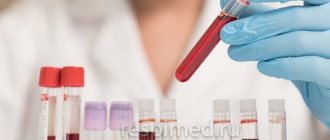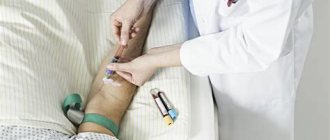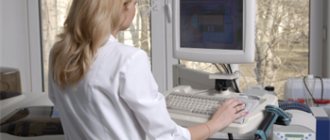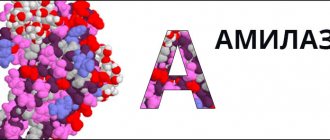Prostate adenoma is an exclusively male disease, causing a lot of worry and anxiety among the stronger sex. And the doctor prescribing any examination only increases the degree of stress. However, it is necessary to understand that a biopsy of prostate adenoma is prescribed only for the purpose of determining which pathology affected PSA values. In case of prostate adenoma, it is important to exclude all urological and oncological diseases, for which a comprehensive diagnosis is carried out, including studies such as a PSA blood test, prostate biopsy, urinalysis for prostate and prostate adenoma.
Normal PSA values
PSA (prostate specific antigen) is a protein synthesized in the prostate. This is an important component of prostatic secretion. Normally, PSA is part of the seminal fluid; only a small amount enters the bloodstream. However, various urological pathologies lead to increased vascular permeability, as a result of which PSA enters the blood in greater quantities.
A blood test for prostate adenoma for PSA level allows you to confirm the diagnosis or identify other diseases before a man develops the first symptoms.
Normally, the PSA level should not exceed 2.5 ng/mg. This indicator is determined for every healthy man no older than 50 years. Due to endocrine changes that occur in the male body after this age, the prostate enlarges, which entails an increase in PSA synthesis. Therefore, over the years, slightly elevated levels of prostate-specific antigen are also considered normal.
PSA reference values:
- up to 50 years – 0-2.5 ng/ml;
- up to 60 years – not higher than 3.5 ng/ml;
- up to 70 years – not higher than 4.5 ng/ml;
- over 70 years old – up to 6.5 ng/ml.
Diagnostic features
Prostate specific antigen (PSA) is a special protein found in the ejaculate and the secretory product of the prostate. A small amount of this antigen enters the blood. The purpose of PSA is to eliminate excessive thickness of the liquid component of sperm.
PSA is synthesized by prostate cells, both tumor and healthy. Therefore, PSA is not an indicator of whether a person is sick or healthy. And even an increase in PSA concentration is not always a confirmation of cancer; it indicates other problems in the male genitourinary system.
PSA is present in the blood in two forms - bound and simple. One type is simple, the remaining two are related. When examining a blood test, the level of free PSA and total PSA is detected (total is the combined value of three types of antigen). An increase in total PSA is a risk of cancer in the human body.
Reasons for increased PSA levels
High growth rates of PSA levels may indicate the transformation of a benign tumor into a malignant neoplasm. However, the fact that PSA is elevated in prostate adenoma does not in all cases mean the development of cancer in the prostate gland.
PSA values in prostate adenoma may increase as a result of the following factors:
- use of certain medications;
- ejaculation committed shortly before the analysis;
- long rides on a bicycle or horse;
- presence of a catheter in the bladder;
- mechanical effects on the prostate gland;
- damage (injury, bruise) to the genital organs.
These factors can lead to distortion of test results, which will lead to unnecessary and sometimes futile worries for men about their health.
How to reduce the risk of prostate adenoma?
To significantly reduce the PSA value, a man must comply with the necessary conditions when taking the test and choose the right drug therapy. Resection of the prostate gland and even traditional medicine can also help.
How to prepare for the analysis?
The PSA level in prostate adenoma can be significantly increased if the basic rules of testing are not followed.
Recommendations that you should familiarize yourself with before the study are as follows:
- the test must be taken on an empty stomach, preferably in the morning;
- 24 hours before the analysis, it is necessary to exclude heavy physical activity and cycling;
- 48 hours before the test, do not have sex;
- 72 hours before the test, do not eat spicy, smoked, fried foods, and also give up alcoholic beverages;
- the interval between the PSA test and any influence on the prostate (massage, palpation, biopsy, removal of the catheter from the bladder) should be at least two weeks;
- 14 days before the PSA blood test, you should avoid taking medications that increase testosterone and increase potency.
Such recommendations contribute to a significant reduction in PSA levels in prostate adenoma.
Surgical method to lower PSA levels
The most effective and radical method of lowering PSA levels is prostatectomy, during which the entire prostate gland is surgically removed. Indications for removal of the prostate in case of adenoma are severe complications of the disease (the man is unable to urinate, and renal failure develops). After removal of the prostate gland, the PSA level should not exceed 0.2 ng/ml. If the PSA value remains high after prostate resection, this may indicate a relapse of the disease or the degeneration of prostate adenoma into a malignant neoplasm.
Medication to lower PSA levels
With the help of properly selected drug therapy for prostate adenoma, it is possible to achieve a significant reduction in the concentration of PSA in the blood, thereby preventing malignancy of the pathological process.
Most often, for prostate adenoma caused by age-related changes, the following medications are prescribed:
- 5-alpha reductase inhibitors: Finasteride, Dutasteride;
- diuretics (thiazide diuretics): Indapamide, Hypothiazide - antihypertensive drugs, but their regular use helps reduce PSA production;
- cholesterol-lowering agents: Ceristatin, Fluvastatin, Pitavastatin.
Patients taking these drugs reported a decrease in PSA levels of almost 50% within a year. If this indicator remains elevated, the doctor reconsiders the proposed treatment regimen due to its ineffectiveness.
PSA test
An antigen test makes it possible to determine the presence or absence of a tumor. But, in order for this analysis to give a reliable result, you need to know how to properly prepare for it. This is done for the reason of eliminating further doubts about the result obtained.
- A few days before the blood test, you need to pay special attention to your diet. It is necessary to exclude alcoholic drinks, fatty, salty and spicy foods and dishes from it. It is also advisable to quit smoking.
- In two days (and preferably more), reduce physical activity, stress on the nervous system, and give up sexual intercourse and masturbation.
- You should not eat before taking blood; the previous meal should take place 8-12 hours before the test. Drinking plain drinking water is allowed.
- Do not smoke the day before the PSA test.
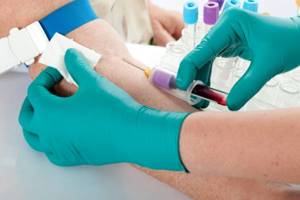
Affect the result or distort its values to some extent:
- age;
- excessive consumption of fatty, salty or spicy foods;
- ejaculation or wet dreams;
- the presence of any inflammation.
If the results are controversial and the diagnosis is in doubt, then repeated and additional studies must be carried out. The diagnosis is never made based on analysis alone.
Biopsy of prostate adenoma: how the procedure is done and its goals
Prostate biopsy is an important and highly informative examination method. With the help of a morphological examination of a sample of prostate tissue, it is possible to reliably diagnose an oncological disease - prostate cancer.
The procedure can be carried out in several ways, which differ in the technique and method of obtaining a tissue sample for a study such as a biopsy of prostate adenoma. The price of a biopsy also depends on the chosen method of execution.
Today, prostate biopsy is performed using the following methods:
- transrectal multifocal method - material is taken through the rectum. After inserting the instrument under ultrasound control into the prostate gland, several (up to 12) samples of biomaterial are taken from different parts of the prostate;
- transurethral method - the required tissue sample is excised using a cytoscope equipped with a cutting loop and a video camera, which is inserted into the urethra;
- transperineal method - to collect biomaterial, an incision is made between the scrotum and anus, into which a biopsy needle is inserted. This technique requires the use of local anesthesia or general anesthesia.
Indications and contraindications for prostate biopsy
Primary prostate biopsy is indicated in the following cases:
- when the level of total PSA in the blood exceeds reference values (defined for each age category);
- if a malignant neoplasm is suspected, which arose during a digital rectal examination of the prostate or transrectal ultrasound.
There are indications for a repeat biopsy:
- if PSA levels continue to rise after the initial biopsy;
- when the tumor marker (free or total) is less than 15%;
- with a PSA density of more than 20%;
- with high grade prostatic intraepithelial neoplasia (PIN) three months after the initial biopsy;
- if there is a suspicion of tumor recurrence after removal (according to transrectal ultrasound);
- with insufficient amount of biomaterial after the initial biopsy.
A full examination, including a prostate biopsy, is necessary, first of all, to determine an accurate diagnosis, since both adenoma and prostate cancer have fairly similar symptoms.
Biopsy of prostate adenoma is contraindicated in patients with the following diseases and conditions:
- prostatitis in the acute stage;
- acute processes in the rectum - complicated hemorrhoids, proctitis;
- general serious condition of the patient;
- blood clotting disorder.
A doctor can diagnose prostate cancer only after performing a biopsy. In the absence of histological examination results, the adequacy of the diagnosis and the chosen course of therapy can be questioned.
Prevention of prostate cancer
Many people wonder whether it is possible to lower the PSA level. The answer to this is obvious - if a pathological process is already present in the body, then the prostatic antigen can be reduced only by receiving treatment. There are no alternative or folk remedies for lowering PSA levels.
However, it is worth taking preventive measures if there were suspicions of cancer and they were not confirmed. Such preventive measures include:
- Moderate physical activity should be firmly established in everyday life. This is gymnastics, sports or swimming in the pool.
- It is important to exclude fats of animal origin, alcoholic beverages and tobacco products from the diet. Particularly healthy foods include tomatoes, vegetables and fruits high in vitamin E and carotene.
- Use of medicines. Regular aspirin, if taken regularly, can reduce PSA by up to 10%.
Possible complications of prostate biopsy
The prostate biopsy procedure may be accompanied by certain risks and complications:
- the appearance of blood impurities in the urine and seminal fluid;
- the appearance of pain during urination and increased urge to urinate;
- acute urinary retention;
- development of acute prostatitis;
- damage to the urethra;
- painful sensations in the rectum and perineum;
- erectile dysfunction;
- increased temperature;
- the occurrence of bleeding from the rectum;
- loss of consciousness.
Most often, such conditions go away on their own a couple of days after the biopsy. However, if fever, severe bleeding, pain and acute urinary retention occur, the patient requires urgent medical attention.
The quality of diagnostics directly depends on the experience and qualifications of the doctor, equipping the clinic with high-tech equipment and many other important factors.
The Yusupov Hospital, one of the most modern medical centers in Moscow, meets all these requirements. Competent clinic specialists will answer all the most frequently asked questions: does PSA increase with prostate adenoma, how and for what purpose is a prostate biopsy performed, how can you reduce the level of PSA in the blood? Diagnostic tests are carried out using the latest equipment of the clinic, which guarantees the most accurate results.


